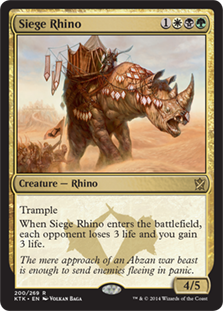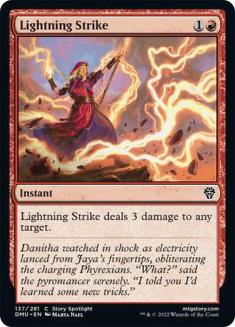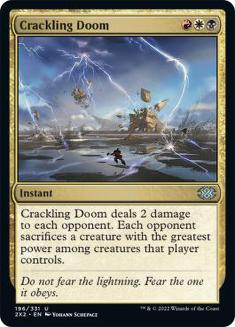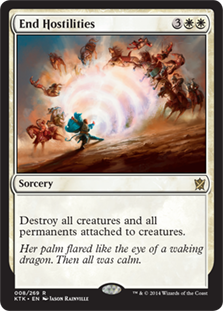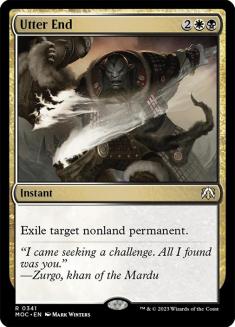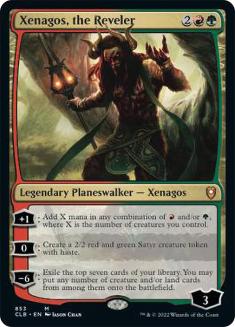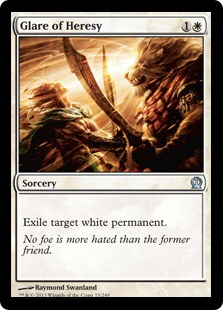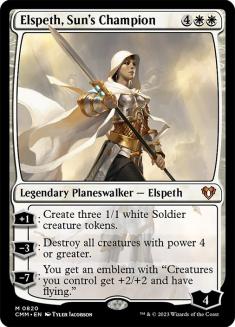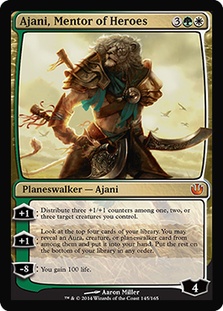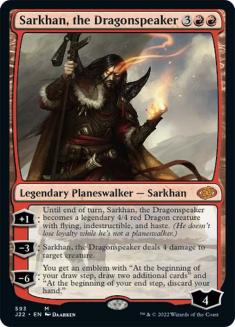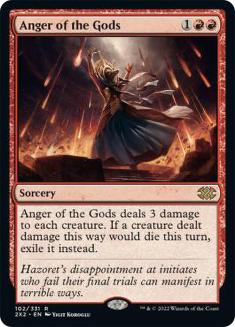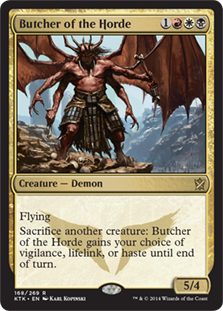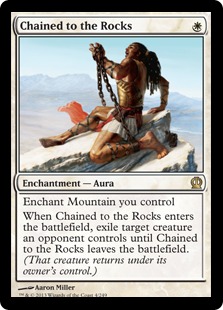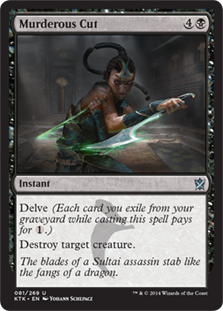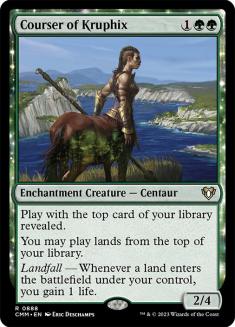This past weekend in Richmond involved one of my most successful thought experiments to date in this Standard format. It all began with the question,” I
wonder if it’s possible to play Chained to the Rocks and Siege Rhino in the same deck?” The initial list looked rough, but I decided to give it a spin
anyway. Four rounds later, I was eleven packs richer and over-stimulated with possibilities. The mana worked and the deck functioned. Not only that, but I
felt like I was doing much more powerful things than my opponents. I was definitely onto something.
Here’s the list for those of you that didn’t keep up with the Star City Games Open coverage this past weekend.
Creatures (17)
Planeswalkers (5)
Lands (25)
Spells (13)
Sideboard

This doesn’t look like anything that has been played in this format to date outside of Joel Larson’s Four-Color Midrange deck from the Pro Tour. He was
definitely onto something, but we just didn’t have the time to get it to where it needed to be. You could say this archetype is extremely innovative, but I
beg to differ. It is simply the product of experimentation in a format where there is very little going on.
I don’t know if people understand how unexplored this format truly is. Last year was a very stifling Standard format where a small handful of decks
dominated for the entire year, but that isn’t this format. The decks we currently call Tier 1 aren’t actually that good. We constantly see new decks pop up
and dismantle them due to how clunky and inefficient they are. They may play great cards, but they aren’t fully evolved and the tech hasn’t been explored.
I simply created something and ran the tables with it this past weekend. I didn’t take countless hours breaking down the subtleties of the strategy. I
jammed Butcher of the Horde alongside Siege Rhino and called it a day. The only two matches I lost were to two masters of their trades (Aaron Barich and
Shaheen Soorani) who also came equipped with creations of their own design. The tournament was eventually won by a brand new decklist surrounded by a Top 4
littered with innovation.
This format caters to those who innovate.
There were numerous things on my mind once I decompressed from the event. First and foremost is the mana in this format. It’s pretty difficult to ignore
the fact that my four-color deck had mana issues in only two games in the entire event. This made me start thinking about the mana in other decks in the
format.
Why does Abzan Midrange run 4 Sandsteppe Citadels? It seems like an obvious four-of the first time you build the deck, but why does the deck really need to
waste four of its enters-the-battlefield-tapped slots on these lands? Has anyone actually tried playing a version of the deck with zero copies of this
tri-land and replacing them with more temples? Why yes internet person, the mana would in fact get “worse,” but is it possible that the mana is too good in
the first place?
To get an immediate answer, I ask all of you Abzan Midrange players to think of the last time you didn’t have a Sandsteppe Citadel in your opening hand of
three or more lands with one being a Temple and had to mulligan due to color screw? Can you even remember a moment this has happened? Just because Ari Lax
won Pro Tour Khans of Tarkir with four Sandsteppe Citadels doesn’t mean it was correct. We can all agree that his mixture of spells was slightly off from
perfect, but we eventually corrected that throughout the months. The mana hasn’t really been touched though.
Now I could easily be wrong, and this weekend of testing will prove it, but I don’t believe that to be the case. I just never thought about it before
playing Four-Color Midrange. I just assumed it was optimal to play four lands that produce all of my colors. I learned something from someone else and took
it for solidified fact.
Learning from others is a great way to catch up, but innovation doesn’t come to fruition through learning. It is created through thinking. Thinking about
how things could be different or figuring things out with your own unique perspective.
I’m excited to start exploring this format through a new perspective. Four-Color Midrange has opened my eyes to the possibilities this format has to offer,
and I can’t wait to start all over with a new way of thinking about things.
I understand that there are multiple large tournaments this weekend and some of you have decided to pick up my Frankenstein monster of a deck, so I guess I
should start talking about that. Four-Color Midrange was a wild success. I didn’t have much faith in the deck going into SCG Richmond, but the deck
performed quite well and got me my first Standard Open top 8 in almost an entire year. Sadly, it was cut short in the quarterfinals, but I will gladly take
the points to cushion my chances of playing in the Players’ Championships.
The deck is fairly straightforward. You develop your manabase, cast big monsters, and kill everything in their way. Sometimes these three steps are done in
a different order, but the end result is that you have the most efficient creatures backed up by the most efficient creature removal the format has to
offer. The most complex part about the deck is how wildly different your strategies are against the different decks of the format. The most crucial thing I
could talk about are the intricacies of all the matchups so that is what I will spend the bulk of my time doing to prepare you for the weekend.
VS Abzan Midrange
This matchup plays out differently depending on if you are on the play or draw, have a Sylvan Caryatid or not, or have drawn Butcher of the Horde. It is
quite easy when you are on the play with a Sylvan Caryatid since you can simply ramp into creatures and easily dispatch any threats your opponent presents
you with. Time is not on their side when they are on the draw. They have removal, but it’s slow, allowing you to present a threat every turn. Each one will
deal some form of damage whether it is the burn from Siege Rhino or haste from Butcher of the Horde/Sarkhan, the Dragonspeaker. Once they have little to no
life, you can simply burn them out with Lightning Strikes and Crackling Dooms.
It becomes much more difficult when you are on the draw. The most important thing to concern yourself with in this position is to never let them trigger
raid for their Wingmate Rocs or run away with the game with Elspeth, Sun’s Champion. This is where Butcher of the Horde comes in. With one resting in your
hand, you can just kill everything until it is time to surprise attack an Elspeth, Sun’s Champion. If the mightiest of the planeswalkers does not show up,
you should be able to just kill everything before playing one of your own.
The other games you lose in this matchup contain Courser of Kruphix and Abzan Charm running away with the game. They have better removal for your
planeswalkers making it difficult to come back from a card disadvantage. You don’t want to play draw go with them, so try to make sure you are always ahead
on the board. Chained to the Rocks and Murderous Cut go a long way with allowing you to cast multiple spells a turn which will, in turn, get you the tempo
boost needed to deal damage.
Out (on the draw):
In (on the draw):
Out (on the play):
In (on the play):
On the draw it is important to take a more controlling approach, but the play is much different. Abzan Midrange has a difficult time when behind, and this
deck can easily accomplish this.
VS Jeskai Aggro
This is the matchup Four-Color Midrange has always wanted. Not only do we have the creature base Jeskai doesn’t want to play against, but the removal they
hate to back it up. I initially thought this was going to be one of the more difficult matchups, but surprisingly Lightning Strike and Siege Rhino do a
good job of mopping the floor with this matchup.
The rules are simple. Kill their things. Play your threats. Win.
Out (on the draw):
In (on the draw):
Out (on the play):
In (on the play):
It is important to respect their creatures when on the draw. Goblin Rabblemaster can get out of control very quickly, which makes it important to be able
to mop up everything with a single removal spell. It is also important to be able to make sure their Wingmate Rocs aren’t easily triggered if people start
playing Kevin Jones’ version of the deck.
Things get rather easy on the play. You have enough time to get Courser of Kruphix or Siege Rhino online before their horde of weenies start swinging. Just
slam some removal into their threats, and they will not be able to keep up.
One of the only difficult lines of play with the deck is realizing when you can play draw go to play around Disdainful Stroke. This is one of the only ways
they have to combat our win conditions, but it doesn’t mean we have to play right into it. Often times, I will let a Courser of Kruphix get me too far
ahead for them to ever get back into the game if they never kill it. It won’t always be correct to let Siege Rhinos clog your hand, but don’t think it is
always wrong to pass without doing something proactive.
VS Whip of Erebos Strategies
Even though there are a million different versions, the games all play out the same. You have to go all-in game 1 and hope to deal them enough damage
before their gameplan comes online. Their lategame embarrasses yours so make sure you deal as much damage as you can. It is often correct to sacrifice an
early Sylvan Caryatid to get in five extra damage with Butcher of the Horde. Once they stabilize, you will have no chance of winning the game.
Since all Whip decks are generally the same even if they run different colors, I pretty much sideboard the exact same play or draw.
Out:
In:
You have no way of playing a normal game against these decks. They have a very powerful gameplan, but one thing they are lacking is maneuverability. They
do one thing and one thing only. It is extremely profitable to become a control deck and lean heavily on planeswalkers to weather the storm. With so much
mass removal, you will find that satyrs and soldiers do a great job at finishing the game out.
VS Mardu Midrange
This is one of the most interesting matchups due to how malleable both decks can be after sideboard. Both decks have the capability to become hyper
aggressive or extremely controlling at any time. The only thing that becomes important is what you think they will do.
All 75 cards are playable in the matchup. This is just one of those times that you will have to create your own personal gameplan for the matchup. The only
advice I can give you is chart out what cards are strong on the play and strong on the draw.
Cards better on the Draw:
Cards better on the Play:
VS Ashiok-based Control Decks
These are far and away your worst matchups. Without the availability to Hero’s Downfall, the deck has a tough time keeping up against planeswalkers on the
draw. I have tried versions of this deck that played better removal and more threats to attack the dreaded planeswalker, but they always ended up making
the deck worse against the field. In the end, I found that this archetype will always have a difficult time dealing with control decks, but there isn’t
really a way around it.
Out:
In:
VS Abzan Aggro
This matchup can play out much differently depending on the build, but the core strategy stays the same. Kill off their creatures as quickly as possible,
but try to set up turns where you can play a threat and a one-mana removal spell. This will allow you to gain a much needed tempo boost by not feeling the
pain of having your creature killed before combat.
One of the more interesting lines you can take is to pick off creatures that will not die to an Elspeth, Sun’s Champion -3. I have even allowed my opponent
to put counters on creatures with Anafenza’s triggered ability just to be able to kill more creatures with the ability. It is not always correct to do
this, but it is one of the ways to blow them out without them ever seeing it coming. They will probably just assume that you didn’t have any removal left.
Out (on the draw):
In (on the draw):
Out (on the play):
In (on the play):
Four-Color Midrange is a great deck for anyone who wants to do the most powerful things in the format, but it is not something I am going to be sticking
to. This is not due to the fact that I think the deck is bad, but due to how complex this format truly is and how I lust to explore everything it has to
offer. Don’t be shocked to find that I am on a new toy next week and an even crazier brew for the Season Four Invitational. I have something I am going to
start working on that I hope blows the competition out of the water and makes some waves.
I’m taking the weekend off so you won’t be finding me in coverage this weekend. The road has worn me down since it began before the Pro Tour, and I am in
desperate need for a weekend off before flying to the West Coast for the Invitational. I revel in the fact that I will be watching Twitch like many others
this weekend as all the Magic coverage unfolds.

